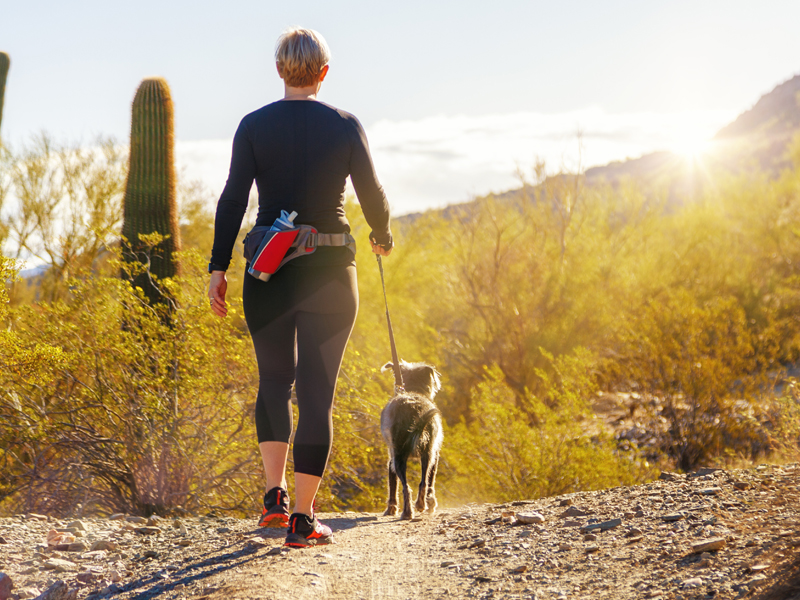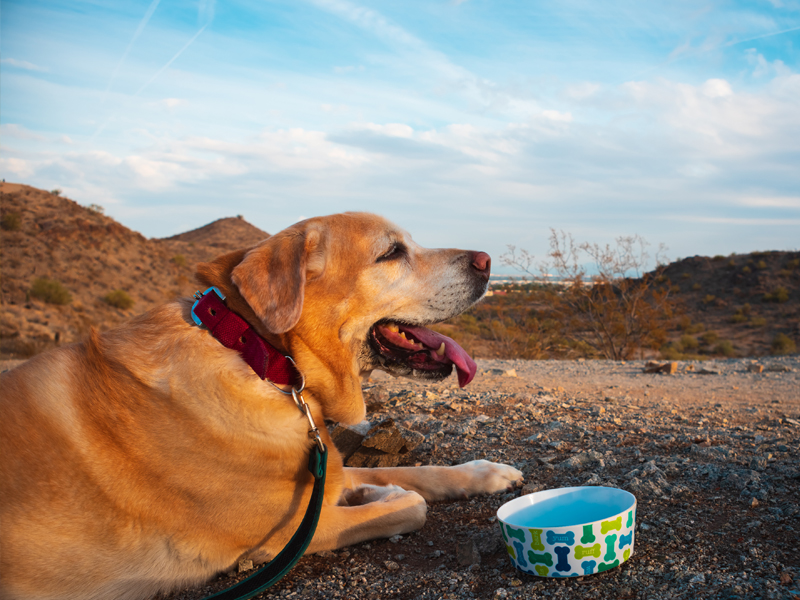Is there such a thing as walking your dog safely in the scorching embrace of an Arizona summer? Only sometimes. Ensuring your furry friend’s well-being during these intermittent walks becomes so much more important. TLC House & Pet Sitting is here to guide you through the essentials for keeping your dog safe on those oh-so-warm days.
Understanding the Impact of Heat on Your Dog
Unlike their wild ancestors, modern dogs live indoors and are more vulnerable to the effects of high temperatures. Their paw pads are less resilient, and they struggle to adapt as swiftly to warmer weather. Thus, it’s your job as a pet parent to recognize the signs of overheating in dogs and be proactive in ensuring their comfort.

Temperature Thresholds for Walks
Determining the ideal temperature for walks is important and maybe a little confusing. At TLC Pet & House Sitting, we have a quick test. If you can’t put your hand on the ground, then it’s too hot to walk your dog. Therefore, we only walk dogs early morning or after the sun goes down.
Even more, at temperatures surpassing 89°F, dogs are at risk of heat stroke, and any reading of 90°F or higher should prompt you to avoid outdoor activity. For several dogs, even temperatures ranging from 70°-77°F can prove excessively warm. High humidity also plays a significant role; if the sum of temperature (in °F) and humidity crosses 150, outdoor exercise should be avoided altogether.
Where we are in Arizona for example, the climate is often very hot and moderately humid in August. Temperatures are up to 106°F on the day of writing this with a humidity of 41%. On average, Phoenix residents (and most cities surrounding) can expect to experience 86°F or higher throughout the month.
Factors Affecting Your Dog’s Heat Tolerance
Your dog’s response to heat hinges on various factors, including:
Breed Considerations
Brachycephalic breeds, characterized by flat faces, such as English Bulldogs, Shih-Tzus, and Pugs, are more prone to heatstroke due to their impaired ability to cool down through panting. Walking these kinds of dogs in hot weather should be approached with caution.
Body Type, Size, and Weight
Smaller dogs possess a higher surface-area-to-mass ratio, allowing them to dissipate heat more effectively than larger counterparts. Overweight dogs are more susceptible to overheating than lean ones.
Age and Health
Senior dogs and puppies struggle to regulate body temperature efficiently, and their sensitivity to heat is heightened. Preexisting health conditions, particularly heart or respiratory ailments, can amplify vulnerability.
Coat Characteristics
Coat thickness and color also influence heat tolerance. Double-coated breeds like Golden Retrievers are prone to overheating, while dark-colored dogs absorb more heat from sunlight.
Don’t Rely on a Fan
Did you know that dogs sweat primarily through their feet? Pets respond differently to heat than people do. And while we love a cool breeze from a fan, they don’t do the job of cooling off pets as effectively as they do humans.
Acclimation and Humidity
Walking your dog in hot weather may be more difficult if your pup isn’t used to those conditions. The general temperature range your dog is accustomed to matters, along with the humidity level. When combined with these factors, you can refer to the following chart for guidance. Remember to do the touch-the-street/sidewalk test first:
Temp °F Recommendation
100° It’s too hot to walk your dog (and yourself, too, probably)
90° Dangerous heat – use caution (go outside for potty breaks only)
80°-89° Modify or skip the walk (early mornings or after sun goes down)
70°-79° Low risk of overheating (depending on the pup, you may need to keep it short)
60°-69° Enjoy your walk!
Ensuring Safe Paw Patrols: Checking Pavement Temperature
While ambient temperatures might seem manageable, the pavement’s heat can be significantly higher, causing potential harm to your pup’s paws. On sunny days, surfaces like asphalt, concrete, or sand can be 40°-60°F hotter than the air temperature. Stop and think about that for a minute. That’s super-duper hot. To test the pavement’s suitability for your dog, place your hand (or bare foot) on a sunny spot – if you can’t endure it for 10 seconds, it’s too hot for your dog.
Recognizing and Preventing Heat Stroke
Heat stroke is a dire concern during hot weather. Dogs are more heat-sensitive than humans, so identifying symptoms early is crucial:
- Fast panting
- Excessive drooling
- Gums turning red, blue, or bruised
- Dry or sticky gums
- Weakness
- Vomiting
- Disorientation
- Seizures

If your dog displays these signs, act promptly. Call or take them to the vet and initiate cooling measures. Move your dog into the shade, apply cool (not cold) water, and avoid laying wet towels. Offer water, but don’t force it. A prompt response can avert severe consequences.
Navigating Hot Days: Safe Walking Strategies
To ensure your dog enjoys walks even on scorching days, consider these strategies:
- Time Your Walks: Opt for early mornings or evenings when temperatures are cooler.
- Plan Your Route: Choose shaded paths and grassy areas instead of hot pavements.
- Adjust Your Pace: Slow down, especially if you have a flat-faced breed, to avoid overexertion.
- Dress for Success: Utilize dog boots and cooling vests to enhance your dog’s comfort.
- Hydration Matters: Carry water and a collapsible bowl for your dog to drink.
- Alternative Activities: Swimming or indoor games can provide exercise without excessive heat exposure.
The Wisdom of Staying Healthy
Not unlike us humans, exercise is easier when we are healthier to begin with. If you’re walking your dog in hot weather, they’ll appreciate all the help they can get. If you’d like to help your pup be able to have a pep in their step, consider their overall diet. Reader’s Digest put together ‘The Very Best Diet for Dogs, According to Vets’. The article quotes a veterinarian as saying “As with people, when dogs eat highly processed foods, we see an increase in chronic inflammation which can show up as arthritis, chronic elevation of liver enzymes, immune thyroiditis, and inflammatory bowel disease, among others.”
Walking Your Dog in Hot Weather: Conclusion
When temperatures surge in Arizona (or anywhere, for that matter), ensuring your dog’s safety becomes an important mission. Armed with the knowledge to read your pup’s temperature cues, assess pavement conditions, and recognize signs of heatstroke, you’re equipped to provide the best care for your furry friend. Remember, a few simple adjustments can make all the difference in ensuring enjoyable walks even on the hottest days.
For More Information
If you have questions about this topic or general questions about pet care, you can contact Kara Jenkins, Owner of TLC House & Pet Sitting. We are also available by email at info@tlcpetsitter.com. View more of our articles on pets here.
